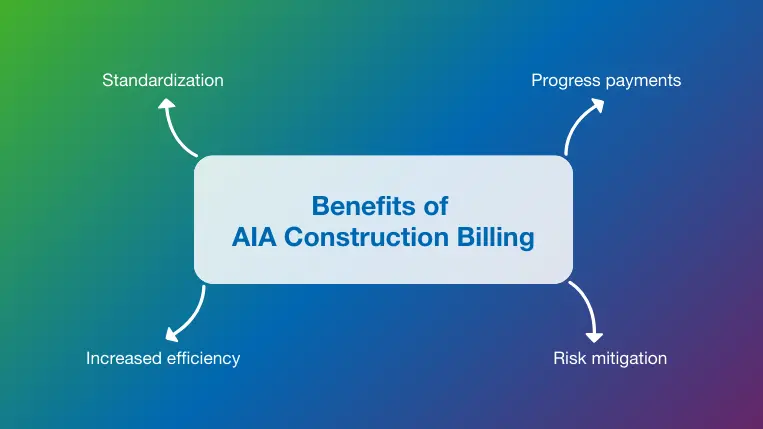11 mins read
What is AIA Billing? Understanding the Benefits and Common Challenges of AIA

Efficient construction billing and payment processes allow contractors to keep their operations lean as they juggle various short- and long-term obligations. The project management and financial tools behind these processes have evolved into standard formats that benefit contractors as well as project owners. AIA billing has become the method of choice to safeguard these essential processes.
What Is AIA Billing?
AIA billing is a standardized process for payment application submission and processing in the construction industry. AIA forms create a structured framework that makes it easier for contractors and their clients to process invoices and payments efficiently.
The American Institute of Architects (AIA) created the billing system as part of the suite of standard documents and templates guiding important transactions between construction project stakeholders. AIA forms have become the de facto industry standard, which makes it essential to understand the purpose and pitfalls of each form, as well as the AIA billing process overall.
Key AIA billing terminology
A full explanation of AIA construction billing and its impact on contractors and clients begins with defining terms and phrases describing key elements of the process. These basic components establish a foundation for many standard cost accounting and tracking processes unique to the construction industry.
- Retainage: Also known as retention or holdback, a retainage is withholding a portion of payment until contracted tasks are completed satisfactorily. AIA billing practices are useful for tracking and managing retainage funds throughout the construction project.
- Schedule of Values: A construction schedule of values (SOV) is an itemized list of activities required to complete a construction project, along with the corresponding cost or value of items completed in each phase. The contract sum is allocated between the portions of work detailed in the SOV.
- Stored Materials: Parts and materials procured by the client or contractor and kept off-site or safely held onsite until they are consumed are known as stored materials. These items include things like screws, nails, joists, and other commonly used products. The AIA billing process helps to segregate the cost of stored materials from the cost of work completed.
Benefits of AIA Construction Billing

The widespread adoption and acceptance of AIA billing can be attributed to the many benefits of this streamlined and well-documented set of practices.
Standardization
The AIA billing process creates a standard framework that enables all contractors and project owners to maintain consistency in their billing and payment practices across various projects. Standardization also makes it easier and faster to process payment applications or compare and consolidate billing documents over time. The straightforward AIA forms often eliminate the need to customize or deviate from standard templates.
Progress payments
Contractors can bill for completed work and stored materials at regular intervals, utilizing the progress payments supported by AIA contract billing. These incremental payments, based on the completion of work items listed in the schedule of values, allow contractors to maintain a positive cash flow and cover their payroll without waiting for project completion. Progress payments also benefit clients by allowing them to assess the quality of each task before proceeding to the next.
Risk mitigation
The structured and transparent cost accounting and invoicing processes supported by AIA billing reduce project risks by providing a real-time barometer of financial health that minimizes surprises, discrepancies, and misunderstandings. Since AIA forms and processes are widely adopted and accepted in the industry, the risks of regulatory and contract non-compliance are also reduced, ensuring successful risk management in construction projects.
Increased efficiency
Standardized practices help to improve the efficiency of billing and payment processes in any industry. When contractors use unfamiliar or unusual document formats for payment applications, this can raise questions or concerns that put payment schedules in jeopardy. With application reviewers well-trained in AIA construction processes, the approval process is accelerated, and supporting information is located more easily.
Key AIA Documentation
Since its founding in 1857, the AIA has provided educational resources, promoted networking, and awarded excellence in architecture. The creation of standardized AIA contract billing documents is another notable achievement, and the specific forms created for billing and payment are recognized for their clarity, simplicity, and transparency.
G702 (Payment application form)
The Application and Certificate for Payment (form G702) acts as the formal request for payment. This one-page form is completed by the contractor and submitted to the client based on work performed within a specified period. Information contained in the G702 form includes:
- The original contract value
- The current billing amount
- Previous amounts billed
- Applicable retainage and taxes
The form also includes a section to reference any applicable change orders and a fixed location to state the amount of payment requested. Signature blocks for the contractor and construction architect are clearly visible.
G703 (Continuation sheet)
The G703 form, known as the continuation sheet, supplements the summarized information in the G702 form, providing a convenient template to itemize the billed work included in the payment request. Column headings in the G703 form include a description of work performed, scheduled value for each line item, stored materials, balance to finish, and retainage amounts.
While the G702 payment application form acts as a cover sheet to capture high-level billing information, the G703 continuation sheet allows multiple work items to be captured effectively. The form breaks the contract sum into portions of work that align with the schedule of values prepared by the contractor. This organized and logical format helps to facilitate efficient review and approval.
Additional documentation
AIA billings using the two primary forms may also require supporting documentation to justify requests for payment or provide more clarity. Examples of documents that may be included with the primary forms include:
- Invoices or receipts for stored materials
- Photos or delivery slips for materials
- Labor or equipment usage reports
- Insurance certificates
- Subcontractor payment summaries
Depending on the type of documentation, it may be included as an appendix or referenced as a separate digital file. In either case, these additional documents should be clearly identified and labeled.
Common Challenges When Using AIA Billing
The widespread acceptance of the AIA billing process speaks to the simplicity and clarity of these standard practices. The AIA has leveraged its resources, experience, and member feedback to deliver user-friendly products. Despite the many benefits, there are still some inherent drawbacks, limitations, and challenges.
1. Lack of customization options
The downside of standardized document formats is the lack of customization options that become useful for unconventional or complex tasks and projects. To address these limitations, contractors can include additional explanations or deviations from the standard process in attachments with fewer format restrictions. This puts the onus on approvers to carefully review supporting files and interpret their impact on top-level sums and balances.
2. Change orders
The change order summary box provides a convenient location to capture additions and deductions related to change orders for each payment application. However, the change order section can also lead to confusion, especially when changes span multiple billing cycles or begin mid-cycle, making it difficult to align the changes with the scope of work captured in the form. Each client will develop their preferred method for clarifying change order accounting.
3. Cost code variation
Cost codes help to define expense categories such as engineering fees, appraisal fees, or specific material types. AIA billing forms are standardized throughout the industry, but no standard AIA codes exist for construction billing. This can lead to confusion or delays when clients attempt to interpret cost codes from contractors with different naming conventions. Many businesses have adopted NAHB and CSI MasterFormat code formats, while others choose to create their own unique codes.
Enhance AIA Billing Processes with Professional Software
AIA billing has empowered construction project stakeholders to manage and track project value and expenses accurately while facilitating timely contractor payments. Construction software solutions help to improve the accuracy and organization of the information captured in AIA documents while supporting transparent collaboration between clients and contractors.
Our professional takeoff and estimating software, RIB CostX, helps to automatically generate cost estimates for work and materials based on up-to-date databases. Estimates can be linked to drawings, ensuring any changes in the design are reflected in the costs, making it easier to measure and price completed work. This progress data can be visualized in an intuitive report, which can be sent to the owner to support AIA billing documentation, making the billing process more efficient.
Discover how our state-of-the-art estimating platform can transform your business, and get your free demo for RIB CostX today!

Most Recent
11 mins read
10 mins read
10 mins read
29 mins read
Blog Categories

Ebook











